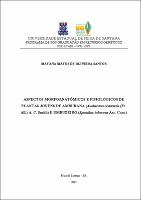| Compartilhamento |


|
Use este identificador para citar ou linkar para este item:
http://tede2.uefs.br:8080/handle/tede/294| Tipo do documento: | Tese |
| Título: | Aspectos morfoanatômicos e fisiológicos de plantas jovens de amburana (Amburana cearensis (Fr. All. A. C. Smith) e umbuzeiro (Spondias tuberosa Arr. Com.) |
| Autor: | Santos, Mayana Matos de Oliveira  |
| Primeiro orientador: | Cruz, Claudinéia Regina Pelacani |
| Resumo: | Os objetivos desse trabalho foram compreender a atuação do sistema radicular da amburana (Amburana cearensis (Fr. All.) A. C. Smith) e do umbuzeiro (Spondias tuberosa Arr. Cam.) na manutenção do crescimento inicial e partição de fotoassimilados das mudas, e determinar a sua contribuição para a sobrevivência das espécies em situações de restrição hídrica. Para tanto, foram realizados estudos a cerca dos aspectos morfoanatômicos, do desenvolvimento inicial e padrões de partição de massa seca na produção de mudas, assim como levantamentos sobre suas trocas gasosas e quantificação e natureza dos compostos armazenados no sistema subterrâneo e folhas de plantas jovens submetidas à condições de restrição hídrica. Para as espécies em estudo, os drenos preferenciais são as raízes tuberosas, seguidos de ramos, folhas e raízes laterais. Inicialmente, as raízes tuberosas se comportam como um dreno de alta atividade, até que se conclua sua formação. As plantas de S. tuberosa apresentaram médias superiores as de A. cearensis para a maioria das variáveis de crescimento estudadas, com consequente crescimento e desenvolvimento mais acelerado. Os resultados demonstraram a interferência no crescimento inicial das plantas causada pela formação da raiz tuberosa, sendo este um órgão de reserva. O sistema radicular das espécies é formado por raízes tuberosas e raízes laterais delgadas. Os cortes transversais demonstraram que as raízes laterais delgadas apresentam periderme, córtex, câmbio e cilindro vascular, além de fibra de sustentação em ambas as espécies e estruturas secretoras apenas na S. tuberosa. O cilindro vascular das espécies é poliarco, sendo endarco e oco na A. cearensis, com parênquima medular evidente, e exarco e sólido na S. tuberosa. As raízes tuberosas das espécies apresentam câmbios adicionais. As espécies apresentam adaptações ao déficit hídrico, como o mecanismo de abertura e fechamento dos estômatos, mecanismo de armazenamento de água e nutrientes em seu sistema radicular tuberoso e mecanismo de ajustamento osmótico. A introdução de plantas jovens de A. cearensis e S. tuberosa pode ser recomendada para programas de restauração de áreas degradadas e manejo florestal. |
| Abstract: | The objectives of this study were to understand the role of the root system of amburana (Amburana cearensis (Fr. All.) AC Smith) and umbuzeiro (Spondias tuberosa Arr. Cam.) In maintaining the initial growth and assimilates partition of seedlings, and determine its contribution to the survival of the species in water restriction situations. For this, studies have been conducted about the early development and dry matter partitioning patterns in the production of seedlings, as well as surveys of their gas exchange, morphological and anatomical aspects, quantification and nature of the compounds stored in the underground system and leaves of young plants submitted to water restriction. For the species under study, preferred drains are the tuberous roots, followed by branches, leaves and lateral roots. Initially, tuberous roots behave as a high activity drain, until it completes its formation. Plants of S. tuberosa showed higher average of the A. cearensis for most of the growth variables, with consequent growth and further development. The results showed interference in the initial plant growth caused by the formation of tuberous root, which is a storage organ. The root system of the species consists of tuberous roots and slender lateral roots. The cross-sections showed that the slender lateral roots have periderm, cortex, vascular cylinder and exchange, and fiber support in both species and secreting structures only in S. tuberous. The cylinder vascular species is polyarc, being endarch and hollow in A. cearensis with obvious pith, and exarco and solid in S. tuberosa. The tuberous roots of species present additional exchanges. The species have adapted to drought, as the opening and closing mechanism of the stomata, water storage mechanism and nutrients in your tuberous roots and osmotic adjustment mechanism. The introduction of young plants of A. cearensis and S. tuberosa can be recommended for restoration programs of degraded areas and forest management. |
| Palavras-chave: | Crescimento Raiz tuberosa Déficit hídrico Fluorescência Growth Tuberous roots Hydride deficit Fluorescence |
| Área(s) do CNPq: | CIENCIAS AGRARIAS |
| Idioma: | por |
| País: | Brasil |
| Instituição: | Universidade Estadual de Feira de Santana |
| Sigla da instituição: | UEFS |
| Departamento: | DEPARTAMENTO DE CIÊNCIAS BIOLÓGICAS |
| Programa: | Doutorado Acadêmico em Recursos Genéticos Vegetais |
| Citação: | SANTOS, Mayana Matos de Oliveira. Aspectos morfoanatômicos e fisiológicos de plantas jovens de amburana (Amburana cearensis (Fr. All. A. C. Smith) e umbuzeiro (Spondias tuberosa Arr. Com.). 2015. 90 f. Tese (Doutorado Acadêmico em Recursos Genéticos Vegetais)- Universidade Estadual de Feira de Santana, Feira de Santana, 2015. |
| Tipo de acesso: | Acesso Aberto |
| URI: | http://localhost:8080/tede/handle/tede/294 |
| Data de defesa: | 24-Set-2015 |
| Aparece nas coleções: | Coleção UEFS |
Arquivos associados a este item:
| Arquivo | Descrição | Tamanho | Formato | |
|---|---|---|---|---|
| TESE - MAYANA MATOS DE OLIVEIRA SANTOS.pdf | Arquivo em texto completo | 6,19 MB | Adobe PDF |  Baixar/Abrir Pré-Visualizar |
Os itens no repositório estão protegidos por copyright, com todos os direitos reservados, salvo quando é indicado o contrário.




